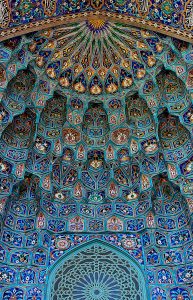
First of all, you should know that there are two famous Blue Mosques in the world. One in Istanbul, Turkey – also known as Sultan Ahmed Mosque and the other one in St. Petersburg, Russia – known as Saint Petersburg Mosque. We are now going to talk about the latter and find out 11 must-known facts about the mosque.
1. It is called the Blue Mosque because the architect Nikolai Vasilyev designed the dome to be covered with blue tiles and blue is the dominant color of the building. The facade of the mosque combines oriental ornaments and turquoise blue mosaic. The dome and both minarets use mosaic of sky-light-blue tiles created by Peter Vaulin in his workshop in Kikerino, a village in Leningrad Oblast.
2. The history of the Grand Mosque of Saint Petersburg is dated back to the 1800’s when Selim-Girei Tevkelev, the appointed Mufti of Orenburg, agreed to handle the construction of a required mosque in Saint Petersburg (still called Leningrad at that time.) And so a committee was assembled to start the plan as well as to gather funds as much as 750,000 rubles in 10 years. The committee was led by Ahun Ataulia Bayazitov.
3. The fundraising was succeeded and the brick laying was held on February 3rd, 1910. The ceremony was done by Ahun Bayazitov, the head of the committee, and attended by the government, social and religious figures namely Mohammed Alim Khan the ambassador of Persia and Ottoman Empire, also the leader of the Muslims party in Duma – Tevkelev.
4. Saint Petersburg’s Blue Mosque is located right across the Peter and Paul Fortress in the center of the city. The land was bought on July 3rd, 1907 under the permission of Emperor Nicholas II. In the following autumn, the commitee approved the project to be handled by architect Nikolai Vasilyev, engineered by Stepan Krichinsky, and supervised by Alexander von Hohen. Skilled craftsmen from Central Asia were also taking part in the project.
5. The design of the mosque was projected to be able to accommodate most of the number of the Muslims living in Saint Petersburg at that time which was around 8,000 people. The pattern of the building adopted the structure of Gur-e Amir, the tomb of Tamerlane in Samarkand, Uzbekistan with three floors to separate the male and female worshippers during the times of prayer.
6. The Blue Mosque of Saint Petersburg was officially opened in 1913 but only got completed in 1921. The length of the mosque is 45 meters with 32 meters of width. The height of the main dome – the blue-tiled one – is 39 meters. The two minarets stand tall at 48 meters.
7. Saint Petersburg Grand Mosque is one of the largest mosques in Russia and is on the list of the seven most beautiful mosques in the country. It is also one of the oldest with a long, remarkable history.
8. In 1940, the government of the Soviet Union closed down all worshipping places including the Grand Mosque of Saint Petersburg. This issue was closely related to the propaganda of communism and atheism that was high at that time. Religious freedom was impossible to achieve. No religious practices were allowed and the mosque was turned into a medical supply storehouse.
9. But, in 1956, when the President of Indonesia – Soekarno at that time – visited Moscow and made a tour to Saint Petersburg (Leningrad back then), he found out that the Blue Mosque was not functioning as it was supposed to be as a worshipping place. The fact disturbed him and so he made an appeal with the government of Russia to return the religious use of the mosque and its maintenance. The meeting ended well and a few days after Soekarno returned to Indonesia, a messenger from Moscow met the mayor of Leningrad and request him to hand the mosque over to the Muslim community. The request was granted and the Blue Mosque was reopened for religious service from then on.
10. The Saint Petersburg Mosque can be found on the corner of Konniy Lane and Kronverksky Prospect, quite near to the Neva River and Gorkovskaya metro station. The minarets can easily be seen from corners of the city.
11. Today, non-Muslims who travel to Saint Petersburg can visit the mosque for a tour organized by the State Museum of the History of Religion called “The East Face of St. Petersburg”. Outside the tour schedule, the mosque is strictly used only for prayers. Tourists can also contact the mosque’s administrators through the mosque’s website to arrange for an appointed tour so they can see the interior of the mosque. Considering that it is a holy place, a lot of respect should be paid and that is why there is a long list of do’s and dont’s for tourists who intend to visit the Blue Mosque. There is also a detailed explanation about the tour. If you haven’t had the chance to travel to Russia in general or St. Petersburg in particular, do not lose hope, you can still enjoy the beauty of the mosque through a virtual tour provided by the website. Make sure you allow flash player on your device for a maximum experience.
Make sure to put the Blue Mosque of Saint Petersburg in your itinerary if you ever going to visit Russia. If you join a group tour, then it is most definitely that you will visit the place. Not only because the mosque is an important landmark in Russia but also because it is located very near to the town’s citadel that almost every tourist would visit when they travel there. From the 11 must-known facts about the Blue Mosque of Saint Petersburg above, you can tell how interesting and beautiful this building is. So it is definitely worth to be put on your bucket list.
